How Much Does Crown Molding Cost?
Updated: Oct. 23, 2023

Consider crown molding costs in light of your budget and DIY skills. Install it yourself, and spend the money you'll save on better crown molding.
Our editors and experts handpick every product we feature. We may earn a commission from your purchases.
You might call it the crowning touch. Crown molding isn’t necessary, but it does an amazing job elevating the appearance of a room. It remains a popular choice today, especially for traditional or transitional-style homes.
Depending on the style of crown molding you choose, it can be relatively inexpensive to purchase and install. Sean Chapman, a professional carpenter in Eugene, Oregon and founder of Tools ‘n’ Goods, says it also has a relatively high return on investment (ROI).
“A properly installed high-quality crown molding can have an ROI of up to 80 percent,” he says.
On This Page
What Is Crown Molding?
Crown molding is a decorative trim that adds a finishing touch to a room. It’s typically installed at the joint where the ceiling meets the wall. But crown molding can be used in other ways — to add eye-catching detail to the tops of cabinets or bookshelves, or at the top of columns.
It can be made from a variety of materials in a variety of profiles or designs, ranging from simple coves to highly detailed motifs. It can be a single piece or several pieces of different types of molding, called “built-up molding”.
Crown Molding Costs
“The main factor that affects the cost of crown molding is the material you choose,” says Chapman. “Average materials run from $1 to $6 per linear foot, while plaster, exotics, solid woods and moldings with custom construction cost from $7 to $40 per linear foot.
“Labor adds $3 to $15 per linear foot. Installation of custom moldings may cost up to $20 per linear foot.”
Below, Chapman breaks down the costs for different materials, all per linear foot. (Note: Prices can vary greatly by region.)
- Plaster: $6 to $12 for materials; $10 to $15 for installation.
- Solid wood: $10 to $15 for materials ($14-$40 for exotic hardwoods); $5 to $10 for installation ($10 to $20 for exotic hardwoods).
- Polyurethane: $2 to $6 for materials; $4 to $5 for installation.
- PVC: $1 to $3 for materials. $4 to $5 for installation.
- Medium density fiberboard (MDF): $1 to $3 for materials; $4 to $5 for installation.
- Polystyrene: $1 to $2 for materials; $4 to $5 for installation.
- Flexible: $4 to $35 for materials; $7 to $12 for installation.
Save Money With DIY Crown Molding Installation
Depending on the type of molding, you could do the work yourself and save a bundle. To DIY the project, Chapman recommends having some basic carpentry experience and skills, plus familiarity with the molding material you choose. If you’re unsure, consult with a pro.
Tools you’ll need
For proper installation, Chapman recommends the following tools:
- Coping saw;
- Drill;
- Hammer;
- Level;
- Miter saw;
- Nail gun;
- Tape measure;
- Wood putty or caulk.
Easiest moldings to install
“Polyurethane and polystyrene crown moldings are not only among the most affordable options, but are also easy enough for DIY installation,” Chapman says. And if you decide to hire a pro for these? “Contractors will generally charge less for the installation of these molding types,” he says.
Hardest moldings to install
“The more complex the crown molding profile is,” says Chapman, “the more skill it requires to be cut and installed properly.” That includes multi-component profiles. Mistakes can be costly. You’ll need to purchase more material, which was costly to begin with.
Have a helper
You could do this project on your own, but the work goes faster and more smoothly if you can round up a family member or friend to help. “You can install lightweight crown molding in small rooms by yourself,” says Chapman. “But average rooms in U.S. houses have mostly wide walls, so it’s not the best idea to install molding without a partner.” Check out this method to cut crown molding.
Work safely
Wear the proper safety gear, including eye protection, work gloves and a face mask. Follow the manufacturer’s recommendations for using construction adhesives. And handle molding safely.
“Long and heavy pieces of molding must be manipulated with a partner,” says Chapman. If you try to manage them by yourself, you may find yourself in an awkward, unsafe position on a ladder. “That’s simply a fall hazard,” he says, “and you don’t want to become a victim.”
